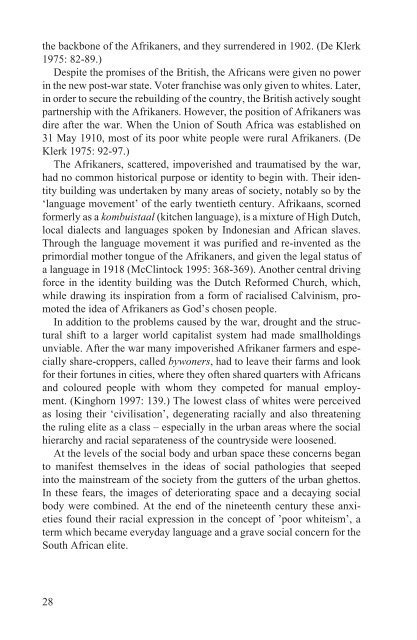The Making of a Good White - E-thesis - Helsinki.fi
The Making of a Good White - E-thesis - Helsinki.fi
The Making of a Good White - E-thesis - Helsinki.fi
Create successful ePaper yourself
Turn your PDF publications into a flip-book with our unique Google optimized e-Paper software.
the backbone <strong>of</strong> the Afrikaners, and they surrendered in 1902. (De Klerk<br />
1975: 82-89.)<br />
Despite the promises <strong>of</strong> the British, the Africans were given no power<br />
in the new post-war state. Voter franchise was only given to whites. Later,<br />
in order to secure the rebuilding <strong>of</strong> the country, the British actively sought<br />
partnership with the Afrikaners. However, the position <strong>of</strong> Afrikaners was<br />
dire after the war. When the Union <strong>of</strong> South Africa was established on<br />
31 May 1910, most <strong>of</strong> its poor white people were rural Afrikaners. (De<br />
Klerk 1975: 92-97.)<br />
<strong>The</strong> Afrikaners, scattered, impoverished and traumatised by the war,<br />
had no common historical purpose or identity to begin with. <strong>The</strong>ir identity<br />
building was undertaken by many areas <strong>of</strong> society, notably so by the<br />
‘language movement’ <strong>of</strong> the early twentieth century. Afrikaans, scorned<br />
formerly as a kombuistaal (kitchen language), is a mixture <strong>of</strong> High Dutch,<br />
local dialects and languages spoken by Indonesian and African slaves.<br />
Through the language movement it was puri<strong>fi</strong>ed and re-invented as the<br />
primordial mother tongue <strong>of</strong> the Afrikaners, and given the legal status <strong>of</strong><br />
a language in 1918 (McClintock 1995: 368-369). Another central driving<br />
force in the identity building was the Dutch Reformed Church, which,<br />
while drawing its inspiration from a form <strong>of</strong> racialised Calvinism, promoted<br />
the idea <strong>of</strong> Afrikaners as God’s chosen people.<br />
In addition to the problems caused by the war, drought and the structural<br />
shift to a larger world capitalist system had made smallholdings<br />
unviable. After the war many impoverished Afrikaner farmers and especially<br />
share-croppers, called bywoners, had to leave their farms and look<br />
for their fortunes in cities, where they <strong>of</strong>ten shared quarters with Africans<br />
and coloured people with whom they competed for manual employment.<br />
(Kinghorn 1997: 139.) <strong>The</strong> lowest class <strong>of</strong> whites were perceived<br />
as losing their ‘civilisation’, degenerating racially and also threatening<br />
the ruling elite as a class – especially in the urban areas where the social<br />
hierarchy and racial separateness <strong>of</strong> the countryside were loosened.<br />
At the levels <strong>of</strong> the social body and urban space these concerns began<br />
to manifest themselves in the ideas <strong>of</strong> social pathologies that seeped<br />
into the mainstream <strong>of</strong> the society from the gutters <strong>of</strong> the urban ghettos.<br />
In these fears, the images <strong>of</strong> deteriorating space and a decaying social<br />
body were combined. At the end <strong>of</strong> the nineteenth century these anxieties<br />
found their racial expression in the concept <strong>of</strong> ’poor whiteism’, a<br />
term which became everyday language and a grave social concern for the<br />
South African elite.<br />
28
















